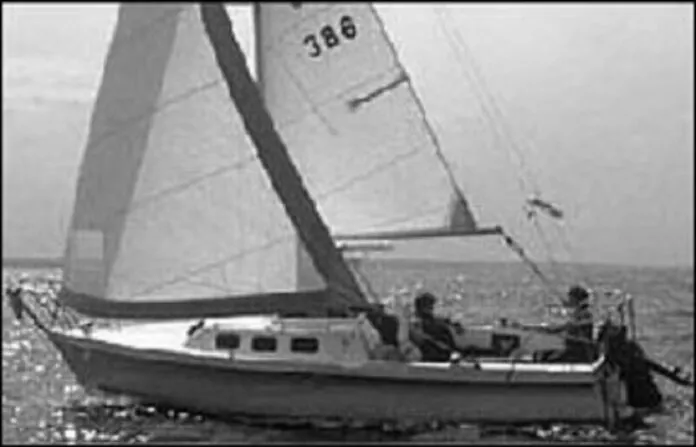As with many of our used boat reports, we invited owners of the Rhodes 22 to comment on its design, construction, quality of workmanship, performance, and customer service from the factory. We received a greater response, and a more uniformly enthusiastic response, than we’ve had to any similar request in recent years. Impressive, especially when you consider that only 50 of these boats are built each year. When we got an opportunity to take one out and put it through its paces, we gained some insight into just what prompted all this loyalty.
Designed by Phillip Rhodes back in 1960, the Rhodes 22 is a trailerable cruiser for a couple that wants the amenities of a larger boat without putting up with the hassles and expenses of a larger boat. It’s clearly not a racing boat. It’s also not a “shoehorn special,” whose claim to fame is how many persons it can sleep. And it’s not an inexpensive boat for its size. The Rhodes 22, from its inception, has been a purpose-built boat. And, with a history of detail improvements and some innovative thinking, it meets that purpose quite well.
The Design
The Rhodes 22 has a fairly long waterline—20′. Overhangs are minimal. This is clearly the first step towards cramming a lot of cruising conveniences into what is, after all, a small boat.
The most readily noticeable feature of its hull is a pronounced flare at the gunwales, much like that found on a 505 or similar racing dinghy. The look is odd on a keelboat, but the flare provides a few notable advantages: The compound curvature stiffens the hull, provides a hiking seat to reduce heeling, helps deflect spray, and provides some extra buoyancy when the boat is heeled over, helping to prevent capsize, according to Stan Spitzer, the owner of General Boats.
Unlike most trailerable sailboats sold today, the Rhodes 22 uses neither a swing keel nor water ballast. Instead, there’s a shoal keel with a centerboard built in. With the board up, the boat draws 20″; 48″ with the board down.
Compared to a swing keel, this arrangement may lose a bit of stiffness because the keel’s weight is carried higher; but it has the advantages of eliminating the swing keel’s highly stressed pivot pin as well as the necessity for a winch and a cable to haul up the keel (which may hum annoyingly when you’re underway).
Compared to water ballast of the same weight, the shoal keel/centerboard arrangement carries its weight lower, making the boat stiffer. In any case, the Rhodes 22 can be sailed in 20″ of water with the board up; it sails just fine that way, though it can’t point as high as it can with the board down. The board is designed to kick up if it strikes an obstruction.
The 100-sq. ft. mainsail rolls up into a 26′ mast and a 175% 200-sq. ft. genoa is roller-furled on the forestay. The arrangement does not make the most efficient sail shape, particularly with a partially-furled jib in heavier weather, and without battens to support a large mainsail roach. But it’s hard to argue with the convenience of this rig. A less-obvious advantage is that you don’t have to deal with the problem of finding a place to store bulky sailbags belowdecks.
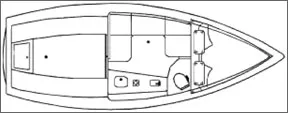
The Rhodes 22 makes up for whatever loss of sail efficiency may be caused by its furling features by providing a generous 300 sq. ft. of sail. Other sail options are available, including a self-tending jib and conventional hank-on sails.
The hinged mast is well-supported by a forestay, a pair of backstays, upper shrouds, forward and aft lowers. Each of these has its own chainplate. One nice thing about having all this standing rigging is that the loss of any one stay shouldn’t bring the mast crashing down. (If the forestay breaks, the forward lower shrouds hopefully will keep the mast up until you can jury-rig a new forestay.)
Chainplates are mounted solidly. The forestay’s padeye is through-bolted to the deck and hull, while the two backstay plates are bolted through the corners of the transom. The upper shroud chainplates are bolted through the hull-deck joint, while the four lower shroud chainplates are glassed into the cabin top. This location provides a “corridor” between the upper and lower shrouds that facilitates movement fore and aft on deck.
Construction
The Rhodes 22’s construction is best described as conventional, with good attention to detail. The hull is laid up with a layer of chop on the skin, followed by a layer of roving, followed by Coremat. The deck uses a glass syntactic foam core, making it and the cabin top about 1″ thick.
Twenty-five different molds provide finished surfaces where otherwise none would exist. The lazarette hatch, for example, has a finished liner instead of a rough fiberglass surface, and coaming compartments have finished, built-in storage shelves. Galley doors are molded in two separate sections and cemented together to avoid warping.
The hull-to-deck joint is a “shoebox” design, with a vertical deck flange slipping over the hull. The joint is screwed together with stainless steel fasteners and then caulked. There are heavier through-bolts at the bow and stern, and at chainplate areas, which are preferable. The joint is covered with a rub rail.
The Rhodes 22 has two molded foam sections glassed into the hull; one under the forward bunk and one under the cockpit sole. Spitzer said that these make the boat unsinkable, an important safety feature not found in most small cruisers.
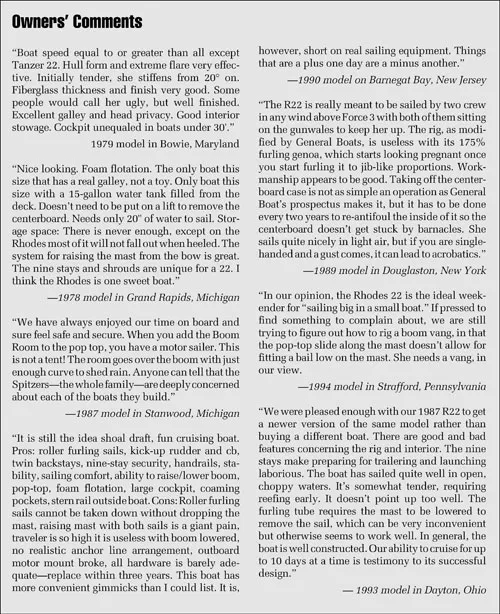
The keel is a molded-in, integral part of the hull, eliminating problems of keelbolts as well as reinforcing the boat’s bottom. Inside, there’s a separately molded centerboard trunk, and 630 lbs. of encapsulated-shot ballast. The centerboard’s pivot is inside the boat and can’t leak; the 70-lb. centerboard requires no hold-down line while sailing, but is still light enough to be raised by a braided pennant and secured with a cleat. It’s made of molded fiberglass with some ballast inside.
Hardware is of good quality throughout. Cleats, for instance, are four-bolt 10″ stainless steel open base models; hand rails, including a unique one at the aft end of the cabin trunk, are stainless steel, though teak is available. Winches are made by Lewmar.
Cockpit
Working on the theory that most cruisers spend much of their time in the cockpit, the Rhodes 22 was designed with a huge cockpit that’s 7′ 4″ long and nearly 8′ wide. It’s self-bailing, with a full-length bench seat on each side. The benches have open fronts, which makes for comfortable seating (closed-front benches force you to keep your legs extended), are independently self-bailing, and there’s room underneath for plastic storage bins. Aft, there’s a transverse bench covering a lazarette, which opens to a 6′ wide area that provides access to transom-mounted hardware as well as a great deal of storage space.
The coamings, which function as backrests, have a pair of compartments, each with two shelves. The flared gunwales are comfortable for hiking out. And there’s a socket in the sole so that a table can be moved from belowdecks to the cockpit. The stern rail is mounted on the side decks, outboard of the coaming, to make sitting on the coaming tops more comfortable. Optional are a pair of swivel seats—complete with backrest and padded armrest on the rail—that mount on the coaming.
The cabin door is hinged horizontally halfway up, with a stainless steel piano hinge. This can be folded out to make a chart table or card table depending upon your inclinations; there’s a molded-in socket for a supporting leg. Or, you can fold the top section down to let you see what the kids are doing in the cabin. Or, you can remove the door completely and stow it inside the gunwale.
All the controls are cockpit-mounted and fall readily to hand. The roller furling control line for the genoa is cleated on the cabin top. The mainsail roller furling is controlled by the outhaul and a control line that passes through the boom, with boom-mounted cleats. The boom can be raised via a topping lift to clear the pop-top, or lowered to reduce heeling. There is no vang, which is unfortunate.
The jib sheets run through adjustable track-mounted blocks to a pair of winches located aft so that they can be handled conveniently by the helmsman for single-handing. The traveler is very unique. It rides on a stainless steel rod mounted transversely across the twin backstays. The mainsheet cleat is mounted on the traveler block; the traveler controls are at the ends of the rod. This arrangement, odd as it may look, keeps the traveler from intruding into the cockpit space, and provides a bit of shock absorption in case of an accidental jibe. We tried it, and it works.
The tiller swings up for stand-up sailing or for easier maneuvering around the cockpit. A hiking stick lets one sail the boat from just about anywhere in the cockpit or up on the coamings, and there are even a pair of clips mounted on the aft rail that hold the tiller in any position in which it is set. The rudder kicks up if it strikes an obstruction, and can be adjusted to provide as heavy or as light a helm as you prefer.
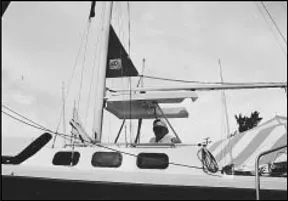
Down Below
The cabin top features a pop-top with 6′ 4″ headroom; when down, there’s about 50″ of sitting headroom. The boat can be sailed with the top in either position.
Like so many other pieces of equipment on the Rhodes 22, the pop-top is a unique design. Unlike most pop-tops, which are supported by pivoting arms, the aft section of the Rhodes 22’s top is supported by a pair of telescoping stainless steel tubes, with spring-loaded detents. To raise the top, you start by lifting the rear portion—lifting only half the top’s weight—until the detents lock into position. A fitting on the forward edge of the pop-top rides in the mast’s sail slot.
There are two side-by-side opening hatches in the deck forward of the pop-top, one above the head and one above the dinette. There’s no gasket between the pop-top and the rest of the cabin—a generous overhang and deep lip allow air to circulate and prevent water leaks. The sliding companionway hatch has a built-in key lock.
The cabin layout of the Rhodes 22 is roomy and remarkably livable. It is, in large part, a tribute to the idea of making a firm decision about what you want a boat to be, and then resisting all temptations to make it something else. The Rhodes 22 is a cruiser for a couple, with possibly several youngsters.
Sleeping accommodations for the couple consist of a 6′ 6″ double berth on the port side of the dinette area; the secondary bunks consist of 6′ V-berths. If you need more sleeping room than this, there’s an optional boom-supported canopy system that General Boats calls a “Boom Room.” It converts the cockpit to a standing-headroom second cabin with a padded floor, and provides luxurious camp-aboard accommodations, though with minimal privacy.
When the dinette berth isn’t in use, half the “mattress” sections become backrest cushions for a settee, while a rotating, telescoping-base table that helps form the center section can be raised to table height and used in the dinette, or moved out to the cockpit, or stored in tracks under the forward deck.
The galley and head are on the starboard side. The galley features a 4-1/2′ counter containing a sink, stove and a large, front-opening icebox with adjustable shelves and an ice-water tap. There’s a large open storage shelf just below the portlights, and a deep cabinet just below that. There’s more storage underneath the counter. Built into the face of the top shelf are 12-volt DC and 110-volt AC outlets. Access to plumbing and electrical connections is good.
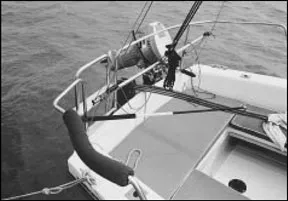
Spitzer (who has a weakness for puns) describes the Rhodes 22’s head as The Swell Head. When we compare it to the primitive accommodations on most small cruisers, we must agree. It’s fully enclosed, with a clever multi-paneled door that opens up to provide a large, non-claustrophobic space, or closes to occupy a minimum of floor space when it’s not in use. Inside, there’s a marine toilet, with sea cock-controlled water intake, holding tank and fittings for dockside pump-out or macerated discharge.
Inside, there is a mirror, cosmetic shelf, toilet paper holder, medicine cabinet, towel rack, magazine rack lighting and a 110-volt outlet for a hairdryer or electric shaver. The sole is tiled. For showering, Spitzer suggests that you take a solar-heated shower in the self-bailing cockpit. The head can be accessed from either the dinette or the V-berths.
The large hatch over the head, aside from providing ventilation and light, performs another function when the pop-top is down. If the 50″ of headroom isn’t enough to permit convenient use of the head, you can open the hatch and let your upper body emerge—presumably with a relieved smile—while you use the head in relative privacy.
Miscellaneous
The Rhodes 22 has so many gadgets that it’s hard to list them all. One particularly nice one is its adjustable motor mount. Instead of the usual recalcitrant jointed aluminum affair, it slides up and down on a pair of low-friction plastic tracks on the port side of the transom. To raise the engine, you pull a rope lanyard that passes through a 6:1 purchase magic box—almost no effort, and excellent position control. There’s a three-step boarding ladder attached to the starboard side of the transom.
Performance
We took the Rhodes 22 out on a breezy day—18-20 knots, with a 1′-3′ chop. Getting underway was as easy as advertised; we started out with the full 175% genoa and full main.
The boat is initially tender, but stiffens up quickly as it heels. The flared gunwales make hiking-out easy (and not particularly demanding athletically); putting two people on the rail did a great deal towards flattening out the ride. We suspect that if we’d been single-handing the boat, we would have reduced sail, just to help keep the boat sailing on her lines.
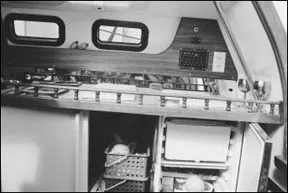
The Rhodes sailed nicely with the board down, and presentably with it up, though pointing ability naturally suffered.
We tried sailing the boat under jib alone, which worked fine, with no problems tacking. We did the same under main alone with similar results. As with any boat, the more a sail is furled, the poorer its shape; after about 30% has been furled, ideally you’d switch to as smaller sail. But when you’re starting with a 175% genoa, you’ll still have a lot of sail up even after furling a third.
In any case, we found the Rhodes 22 to be a lively-feeling boat that’s fun to sail, which is probably more important in a cruiser than absolute speed. The hull is fast, especially off the wind. The Rhodes has a PHRF rating of about 258, which is a bit faster than, say, the Catalina 22 (270), the O’Day 22 (279) or the Chrysler 22 (282) It’s by no means a racing boat (the J-22 has a rating of 177).
The Rhodes 22 is an easy boat to sail, with enough basic adjustments to satisfy most sailors, though we do wish for a boom vang. Controls are very well laid out for sailing from just about anywhere in the cockpit, though we’d like to see foot rests or toe straps to help keep the skipper and crew from sliding about in the large open cockpit.
Conclusions
It’s nice to see a boat that does what it’s intended to do as well as the Rhodes 22 does. It’s a cruiser, and packs a lot of cruising capability into a small trailerable boat. You can daysail it, obviously, but it’s really on the pricey side if a daysailer is all you want. Andyou can squeeze some more adults aboard for cruising, but at the expense of comfort, privacy or both. As a cruiser for two, it’s hard to beat without going up considerably in size and price. The reports we’ve received from readers are almost universally enthusiastic.
General sells the Rhodes 22 in a variety of models, depending upon equipment, from $19,000 to $29,000. General Boats has a buy-back policy for used boats, so that factory-reconditioned models are available, at prices starting from about $10,000.






























